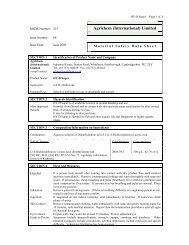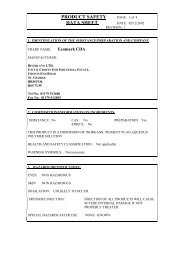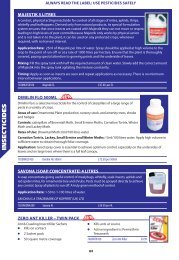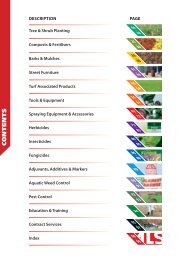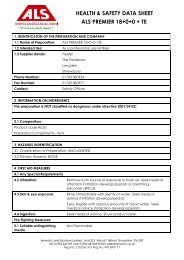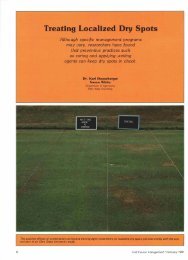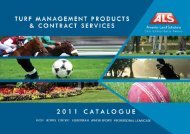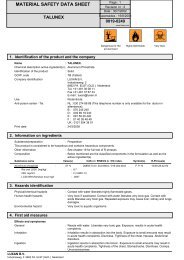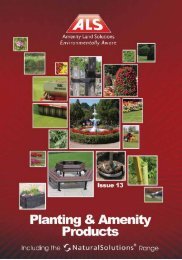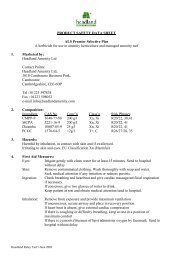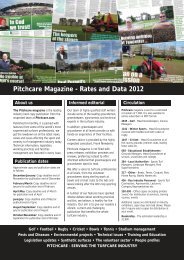Earning his Spurs - Pitchcare
Earning his Spurs - Pitchcare
Earning his Spurs - Pitchcare
You also want an ePaper? Increase the reach of your titles
YUMPU automatically turns print PDFs into web optimized ePapers that Google loves.
Perhaps the most<br />
sustainable crop on<br />
the planet, seaweed is<br />
being heralded as the<br />
answer to the ever<br />
decreasing list of<br />
chemical products for<br />
the turfcare industry<br />
The Wracks<br />
Progress!<br />
Seaweeds are found throughout the<br />
world’s oceans and seas and none are<br />
known to be poisonous. Many are<br />
actually nice to eat and even considered a<br />
great delicacy in many Asian countries.<br />
Seaweeds are also used in many maritime<br />
regions for industrial applications and as a<br />
fertiliser.<br />
The role of seaweed in agriculture dates<br />
back thousands of years, and has been an<br />
integral part of coastal farming, and it can<br />
be said, with honesty, that it is a most<br />
effective fertiliser. Whilst it is still used in<br />
all of these ways, a significant event took<br />
place at the end of the last century that<br />
dramatically changed the way in which we<br />
now look at seaweed and its potential<br />
utilisation.<br />
In 1992, more than one hundred Heads<br />
of State met in Rio de Janeiro, Brazil for<br />
the first international Earth Summit,<br />
convened to address urgent problems of<br />
environmental protection and socioeconomic<br />
development. The assembled<br />
leaders signed the Convention on Climate<br />
108<br />
Change and the Convention on Biological<br />
Diversity, endorsed the Rio Declaration<br />
and the Forest Principles, and adopted<br />
Agenda 21, a 300 page plan for achieving<br />
sustainable growth in the 21st century.<br />
The UN implored governments to<br />
rethink economic development and find<br />
ways to halt the destruction of irreplaceable<br />
natural resources and pollution of the<br />
planet. Following t<strong>his</strong> UN mandate, the<br />
EEC invested in several projects to replace<br />
existing chemicals known to be toxic or<br />
hazardous, and be replaced with<br />
sustainable, environmental and ecologically<br />
friendly solutions that perform as well as<br />
the chemicals they replace. It was following<br />
the successful conclusion of one such<br />
project that explored the potential of the<br />
properties of seaweed, that Sea-Chem was<br />
formed.<br />
Many products used throughout industry,<br />
agriculture and the home contain<br />
chemicals known to be toxic or hazardous.<br />
An increased awareness of the effects of<br />
chemicals on human health, coupled with<br />
escalating levels of global pollution, has<br />
driven governments across the world to<br />
produce ever more stringent chemical and<br />
environmental legislation.<br />
In order to comply with t<strong>his</strong> legislation,<br />
there is a growing demand for safe<br />
alternatives to traditional chemical<br />
products. Sea-Chem was established to<br />
fulfil t<strong>his</strong> demand, and it is against t<strong>his</strong><br />
ethos that our product range has been, and<br />
continues to be developed. None of the<br />
products carries any hazardous<br />
classification symbol.<br />
The Virtuous Circle<br />
Process Efficiency - Solution as effective as<br />
the chemicals it replaces<br />
Ecologically Enhancing - Natural enzymes<br />
help nature diffuse hydrocarbons<br />
Environmental Superiority - No harmful<br />
substances, Lower Carbon footprint<br />
Naturally sustainable - Seaweed<br />
replenished on a 3-5 year cycle<br />
Cost Effective - Lower energy, COSHH<br />
Regulations, Highly efficacious, Operator<br />
benefits, Disposal costs



